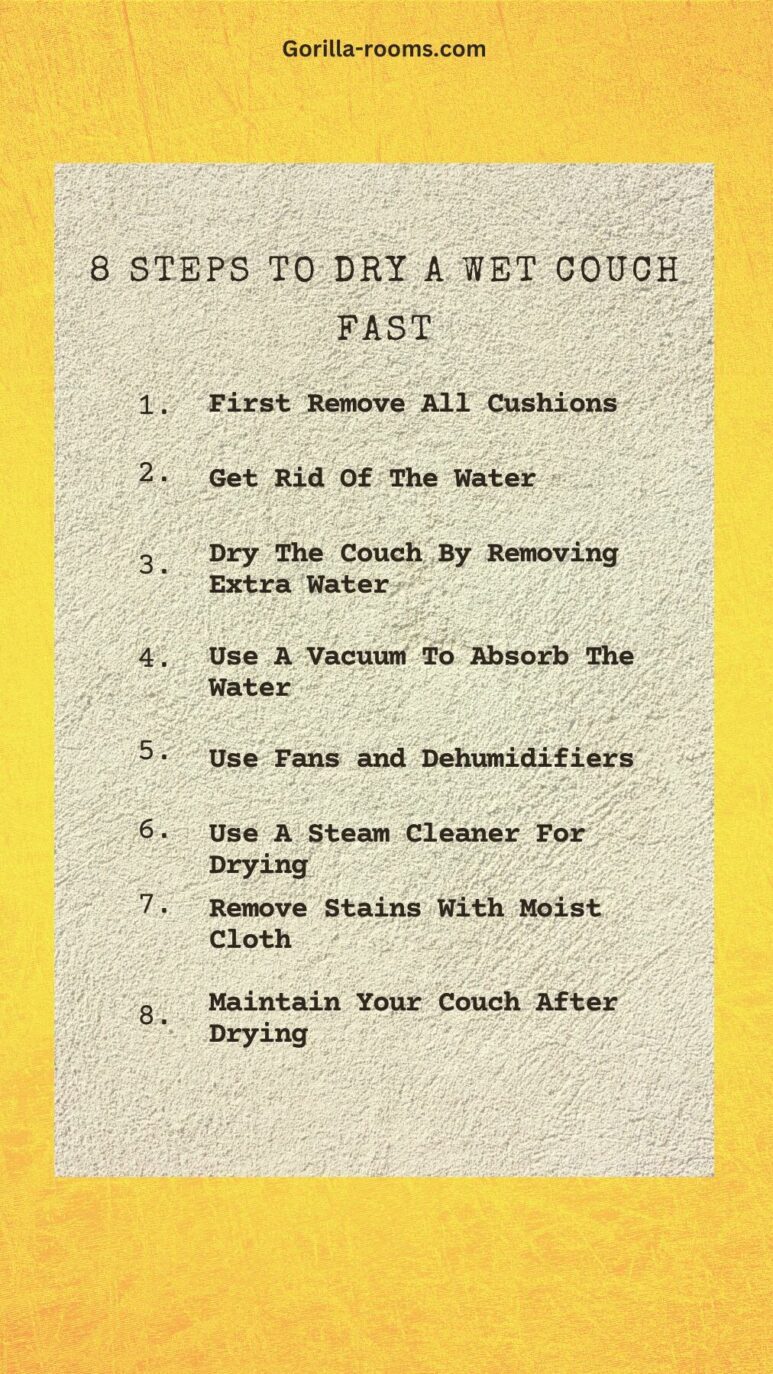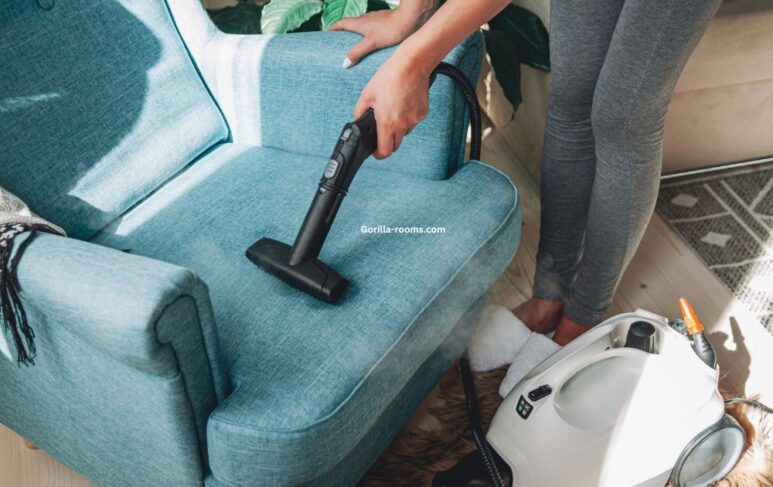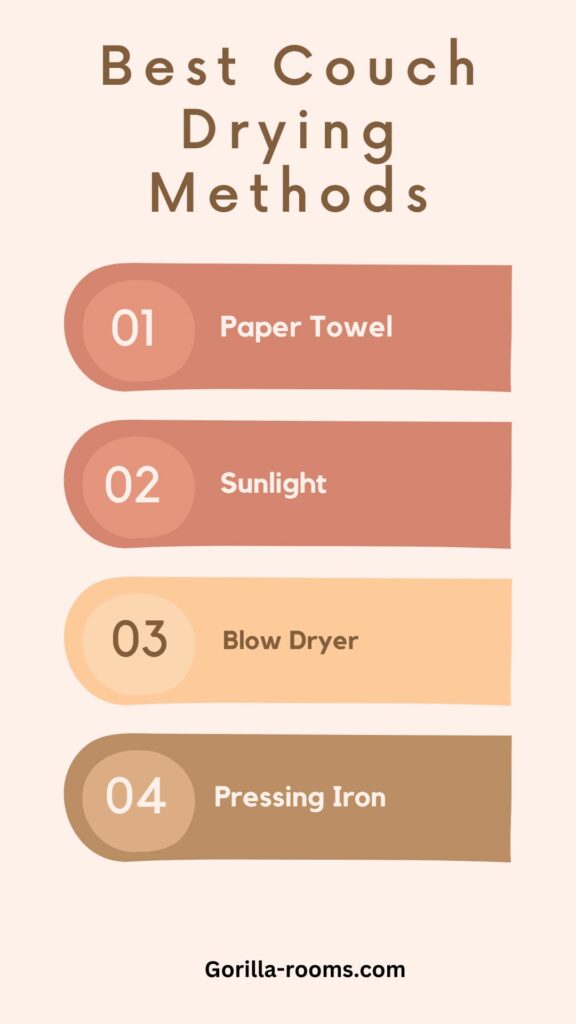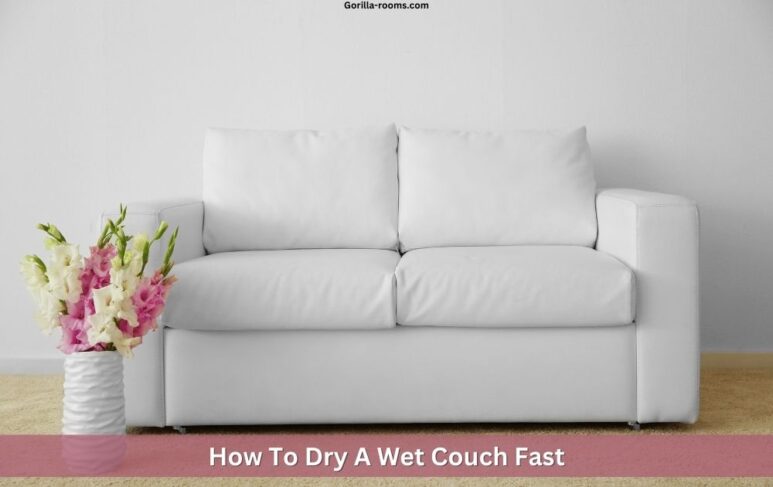Keeping your couch dry is very important to ensure the extended life of the couch and maintain your living room’s pleasant smell.
Drying a wet couch faster after it gets ruined due to rainfall or leaking roofs is more complex than it seems and may be time-consuming, depending on the material used.
But you don’t have to worry about drying your couch.
There are a lot of methods to dry couches fast, but a better way is to use a steam cleaner, humidifier, or ceiling fan.
In this article, I will share some of the best methods to dry the couch fast and remove water stains from the couch, so keep on reading.
How To Dry A Wet Couch Fast – Few Steps
To dry your couch, you may need to use some DIY techniques. However, you may use various methods to speed up the drying process of a wet couch without turning to expensive equipment.

1. First Remove All Cushions
Couch cushions should be removed and stored somewhere safe where they won’t get dirty or damaged. After this, wash off each cushion to eliminate any mud or debris that may have gotten attached.
Putting out the couches in the sun can help them dry more quickly. Alternately, if that is feasible, you may put up fans to blow air on them, directing the wind toward the cushions’ fabric.
2. Get Rid Of The Water
The first basic step in drying a sofa is to remove any excess wetness or moisture. It may take quite some time to dry wet items, even when using strong fans or blow dryers.
Before moving on to other tasks, you should focus on removing as much liquid water as possible and clearing away any significant, dense puddles. It will reduce the likelihood of making stains that are hard to remove later.
3. Dry The Couch By Removing Extra Water

Place a fan behind the couch with the blades pointing toward the seats. Make sure there are no gaps or openings in the couch’s fabric that might allow wind to enter and cause a chill effect.
Leave the fan on the spot for at least a day to ensure that all moisture has evaporated from the inside filling of your pillows and cushions. The next step is to put the sofa back where it normally is or bring it back inside.
4. Use A Vacuum To Absorb The Water
Fabric couches need a lot of water removal, so use a vacuum hose to remove as much as you can. A soft-bristled brush is preferable if the material is leather.
It’s important to take care while using a vacuum cleaner to avoid puncturing your leather.
After you’ve finished vacuuming, take a step back to inspect the couch from a distance to see if any further water has gathered in any inaccessible locations. If that’s the case, you might try swabbing the couch to dry it.
Related Post: How To Clean Microfiber Couch With Green Machine?
5. Use Fans and Dehumidifiers
Couches may be dried quickly and easily with the help of fans and dehumidifiers after being cleaned. You may utilize each of these tools together or individually.
Another option is to make use of huge plastic containers fitted with airtight lids and position them either next to or below your couches.
Place a towel and a dehumidifier inside each container to help absorb any extra moisture. It will fully dry your couch and prevent it from getting a foul smell.
6. Use A Steam Cleaner For Drying
The use of a steam cleaner is another strategy to dry wet couch fast. Excess moisture may harm the sofa; therefore, this step should only be taken once all other preparations have been made and the cushions have been removed.

Lightly brush the cloth with the nozzle extension of a steam cleaner, giving special attention to any spots that gather water during downpours.
It’s important to check the instructions on your steam cleaners before using them since some are more suited to eliminating excess moisture than dust and debris.
7. Remove Stains With Moist Cloth
Use a moist cloth to dab at the stained area if any water stain remains after the fabric has been dried thoroughly. If it doesn’t do the trick, wet the towel with some hand soap and try swiping it around again. Next, dry the area with a fresh towel and double-check your progress.
Some people recommend putting a little toothpaste on a cloth and dabbing the area again if the outline is still visible.
If the stain was caused by dirt or dust, this should get rid of it. You can dry a sofa on your own if you follow the instructions above.
8. Maintain Your Couch After Drying
Prevention is the key to keeping your sofa dry when it rains. You can use any waterproof sofa cover to prevent it from water spills.
To avoid getting wet on the cushions, you should do this before it starts raining.
The rain probably won’t ruin your couch if you store it somewhere dry until it stops. A mattress protector is another option since it will keep the fabric safe from the rain.
You may do a number of things to dry out your couch if it still gets wet after you’ve established a water barrier.
Best Methods To Dry Couch Fast

The following are the best methods for quickly drying a wet couch fast.
1- Paper Towel
It is advised that you wrap the paper towel in many layers in order to absorb sufficient water from the sofa while using paper towels to remove excess moisture.
The best course of action is to wipe the stained area with a dry paper towel after applying the cleaning solution rather than to rub. It won’t be hard to remove the stains.
2- Sunlight
The sun’s heat may effectively stifle any bad odor, making it an excellent option for quickly drying your damp couch. Put your sofa out in the open, preferably in the sun, and walk away for a while.
Couches may be dried rapidly using these methods, and you won’t have to worry about any moisture-related stains emerging.
3- Blow Dryer
A hairdryer may be used instead of sunshine to dry a damp sofa, depending on how drenched it is. However, drying the wet couch this way might take up to 20 minutes and it needs you to keep the hairdryer motionless.
Also, concentrating on a single wet patch for a long before moving on to the next can be a little unpleasant.
4- Pressing Iron
Though it may seem strange, a pressing iron may be used to swiftly dry off a wet couch.
That’s because the high temperatures produced by these irons will quickly dry the sofa and neutralize any unpleasant odors it may have produced.
Use caution since you risk doing further damage to the sofa; iron at a low setting if necessary.
Fastest Drying Materials Of Couches
It is essential to learn a little about the materials of your sofa since some fabrics dry faster than others. It involves the fabric’s texture and stitch count.
- The fabric may have been engineered to dry quickly if your sofa is relatively new. This kind of cloth is often a combination of materials and is known for its moisture resistance.
- Knowing what kind of material you have will be useful. These days it’s not uncommon to see cotton-fabric couches. These are pretty simple to dry, depending on the thickness of the cloth.
- Linen is another prevalent sofa fabric. Being thicker and less porous than cotton, this one may take longer to dry.
- Polyester couches are fantastic because they dry rapidly and repel stains better than other materials. Polyester is soft and durable, perfect for covering everyone in the family, even the dogs.
- Microfiber is often a combination of polyester and other fibers for comfort. This material lasts long, is pleasant to sit on, and is simple to maintain.
How Long Does A Wet Couch Take To Dry
A couch usually takes 8-12 hours to dry after being cleansed. However, using the fans may reduce the drying time by at least half.
But no one knows how long exactly a wet couch takes to dry, because it depends on few factors. Like couches with cotton fabric dry faster than silk an and linen.
Similarly, the nature of the water stain or how much water spills on your couch also counts for the drying time.
Why Is Keeping The Couch Dry Is Necessary
You should thoroughly dry your couch before sitting on it because it will get you gradually wet.
You cleaned your sofa in the first place to eradicate any remaining scents and give it a clean, new appearance.
- Even if your couch cushions just get a little moist, they might start to smell mildewy if you place them on the couch.
- When there’s moisture present, mold is another issue to consider. Mold may develop on many other types of materials besides just food.
- It creates a musty smell and lingers for a long time. You’ll have to wash and dry your clothes all over again.
- Fabrics may be damaged by prolonged exposure to high humidity if they are kept wet or moist. Because of this, mold may easily grow within.
Last but not least, if you want your sofa to last for a long time, you should constantly dry your couch after washing them. It will ensure that they don’t become moldy.
How To Prevent Dampness On The Couch After Drying
Dampness may cause harm to things if it grows and expands. The following precautions are used to prevent couches from becoming humid:
- Sun- Sunlight is an accessible resource. The sun may quickly evaporate the moisture from the upholstery. When it seems to be becoming wet, put it in a location where sunshine may reach.
- Equipment — Equipment such as a vacuum cleaner and a brush are the fundamental instruments required in homes. The brush is utilized to clean the item of dirt and dust. The vacuum cleaner is used to remove all debris from the surface of the couch in order to preserve it.
- Dry Clothing — Utilize dry attire. A wet towel might make the surface dirtier because it can absorb moisture and soften the wood.
- Naphthalene Balls — These are widely used balls. They prevent couches from becoming damp. It is frequently used.
- Open Space — To expedite the drying process, open the windows and doors. It also preserves the couches from damage.
Conclusion
It is crucial to dry a wet couch fast and effectively. The ideal method is to use a fan or air-dry the couch in the sun.
If none of these is possible, consider laying clean towels over the couch and then wrapping them with a plastic cover before switching on your heaters.
You may get an even better and clean result by vacuuming the towel-covered area once the excess water has dried from your furniture’s surface.
It is all you need to know in this quite instructive and detailed article in order to get a wet couch dry fast.
FAQS
How do you fast dry a wet couch?
You may increase drying rates by adding heat to the drying atmosphere using the customer’s HVAC equipment or by bringing in warmer (and low-humidity) outside airflow.
How do you fix a wet couch?
Fabric steamers and steam irons are by far the most efficient means of eliminating water stains from your couch.
Related Posts:
- How Keep Couch Cover In Place?
- How To Get Beer Smell Out Of Couch?
- Can You Wash Suede Couch Covers?
- 7 Best Couch Cushion Support For Sofa
- Best Tips To Remove Water Stains From Polyester Couch?

